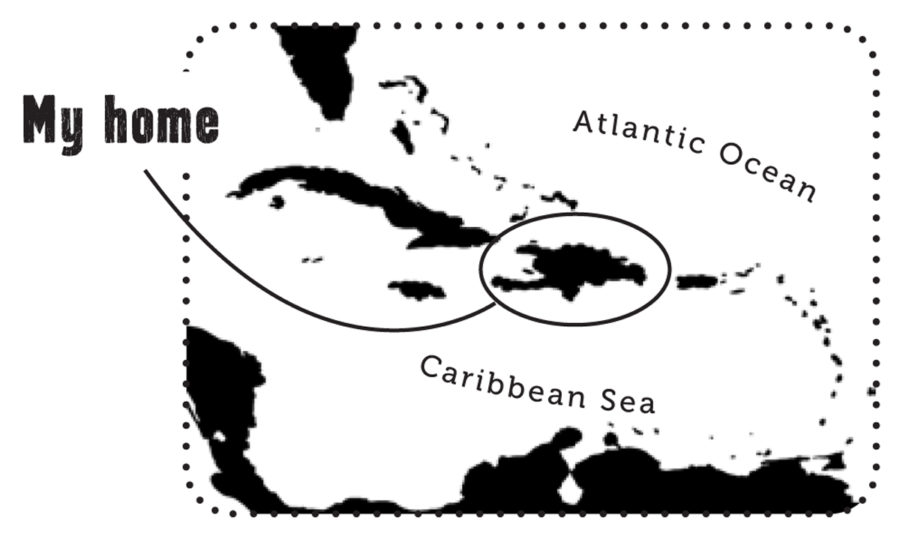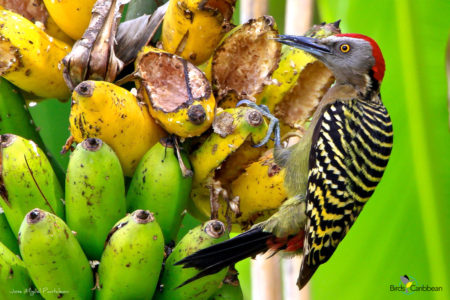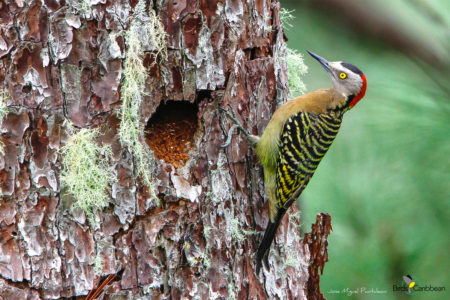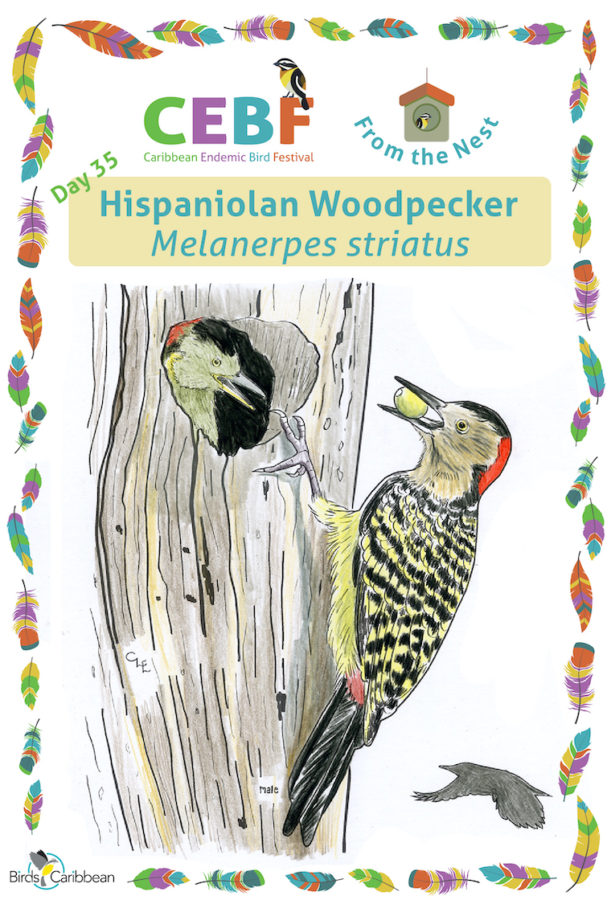Celebrate the Caribbean Endemic Bird Festival (CEBF) with us in our virtual “From the Nest” edition! Have fun learning about a new endemic bird every day. We have colouring pages, puzzles, activities, and more. Download for free and enjoy nature with your family at home.
Endemic Bird of the Day: Hispaniolan Woodpecker
 Hispaniolan Woodpecker – friend or foe? This charismatic endemic is found all over the island of Hispaniola and has garnered quite the reputation for itself. With darting lemon yellow eyes, and sporting a flashy bee-striped back pattern, these loud birds can often be seen throwing their heads back and proclaiming a loud waaakkkkkaaaaa to the world. Unlike most woodpeckers they are very social, often nesting in loose colonies of up to 20 pairs. Pairs excavate a cavity for nesting and the adults in the colony defend the nesting tree. Pairs greet each other upon arrival to the cavity by swinging their heads from side to side.
Hispaniolan Woodpecker – friend or foe? This charismatic endemic is found all over the island of Hispaniola and has garnered quite the reputation for itself. With darting lemon yellow eyes, and sporting a flashy bee-striped back pattern, these loud birds can often be seen throwing their heads back and proclaiming a loud waaakkkkkaaaaa to the world. Unlike most woodpeckers they are very social, often nesting in loose colonies of up to 20 pairs. Pairs excavate a cavity for nesting and the adults in the colony defend the nesting tree. Pairs greet each other upon arrival to the cavity by swinging their heads from side to side.
Although Hispaniolan Woodpeckers prefer to build their nests in Royal Palm trees, many people misperceive this bird as a pest, believing it prefers Dominican homes. But it does not, and these birds are actually quite useful to keep around. First, they are valuable seed dispersers. They eat a variety of native fruits and through their poop, help to regenerate deforested palm savannah pastures. Second, they are fond of eating those pesky large cockroaches that many people are not too keen to host in their homes. Many people did not realize that the woodpecker provided these valuable ecological services. In the past, it used to have a bounty, with the government paying for each woodpecker tongue collected. Thankfully, even with a price on its head, the woodpecker has persisted, remaining a common and widespread bird.
Hispaniolan Woodpeckers are buffy dark-olive below, their back is covered in yellow and black stripes. Males have a red crown and nape while females have a black crown and red nape. Their tail base is brilliantly red while the tail itself is black. The rump is olive-grey. Males are larger than females and their bill size is ~20% bigger. They eat insects, fruit, and seeds taken through gleaning, probing and pecking on trees, bushes, epiphytes and cacti. Learn more about this species, including its range, photos, and calls here.
Download the page from Endemic Birds of the West Indies Colouring Book. Use the drawing above or photo below as your guide, or you can look up pictures of the bird online or in a bird field guide if you have one. Share your coloured-in page with us by posting it online and tagging us @BirdsCaribbean #CEBFfromthenest
Listen to the call of the Hispaniolan Woodpecker
The Hispaniolan Woodpecker is quite vocal, emitting a range of sounds including yapping, squeaking, rolling and nasal calls. They give a long series of up to 23 notes in long-distance communication. Drumming is done only occasionally.
Puzzle of the Day
Click on the image below to do the puzzle. You can make the puzzle as easy or as hard as you like – for example, 6, 8, or 12 pieces for young children, all the way up to 1,024 pieces for those that are up for a challenge!


Activity of the Day
FOR KIDS & ADULTS: Enjoy this video of a male Hispaniolan Woodpecker feeding by probing and pecking on a tree trunks to find insects.
This video has some great footage of a female Hispaniolan Woodpecker perched on a tree trunk and calling repeatedly.

